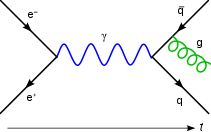In physics, the Callan–Symanzik equation is a differential equation describing the evolution of the n-point correlation functions under variation of the energy scale at which the theory is defined and involves the beta function of the theory and the anomalous dimensions.
As an example, for a quantum field theory with one massless scalar field and one self-coupling term, denote the bare field strength by and the bare coupling constant by . In the process of renormalisation, a mass scale M must be chosen. Depending on M, the field strength is rescaled by a constant: , and as a result the bare coupling constant is correspondingly shifted to the renormalised coupling constant g.
Of physical importance are the renormalised n-point functions, computed from connected Feynman diagrams, schematically of the form
For a given choice of renormalisation scheme, the computation of this quantity depends on the choice of M, which affects the shift in g and the rescaling of . If the choice of is slightly altered by , then the following shifts will occur:
The Callan–Symanzik equation relates these shifts:
After the following definitions
the Callan–Symanzik equation can be put in the conventional form:
being the beta function.
In quantum electrodynamics this equation takes the form
where n and m are the numbers of electron and photon fields, respectively, for which the correlation function is defined. The renormalised coupling constant is now the renormalised elementary charge e. The electron field and the photon field rescale differently under renormalisation, and thus lead to two separate functions, and , respectively.
The Callan–Symanzik equation was discovered independently by Curtis Callan and Kurt Symanzik in 1970. Later it was used to understand asymptotic freedom.
This equation arises in the framework of renormalization group. It is possible to treat the equation using perturbation theory.
See also
Notes
- Callan, Curtis G. (1970-10-15). "Broken Scale Invariance in Scalar Field Theory". Physical Review D. 2 (8). American Physical Society (APS): 1541–1547. Bibcode:1970PhRvD...2.1541C. doi:10.1103/physrevd.2.1541. ISSN 0556-2821.
- Symanzik, K. (1970). "Small distance behaviour in field theory and power counting". Communications in Mathematical Physics. 18 (3). Springer Science and Business Media LLC: 227–246. Bibcode:1970CMaPh..18..227S. doi:10.1007/bf01649434. ISSN 0010-3616. S2CID 76654566.
- Symanzik, K. (1971). "Small-distance-behaviour analysis and Wilson expansions". Communications in Mathematical Physics. 23 (1). Springer Science and Business Media LLC: 49–86. Bibcode:1971CMaPh..23...49S. doi:10.1007/bf01877596. ISSN 0010-3616. S2CID 119431863.
References
- Jean Zinn-Justin, Quantum Field Theory and Critical Phenomena , Oxford University Press, 2003, ISBN 0-19-850923-5
- John Clements Collins, Renormalization, Cambridge University Press, 1986, ISBN 0-521-31177-2
- Michael E. Peskin and Daniel V. Schroeder, An Introduction to Quantum Field Theory, Addison-Wesley, Reading, 1995. 2nd edition, pbk. Westview Press. 2015.
- Berg, Michael (10 February 2016). "Review of An introduction to quantum field theory by Peskin & Schroeder". MAA Reviews, maa.org.

 and the bare coupling constant by
and the bare coupling constant by  . In the process of
. In the process of  , and as a result the bare coupling constant
, and as a result the bare coupling constant 
 . If the choice of
. If the choice of  is slightly altered by
is slightly altered by  , then the following shifts will occur:
, then the following shifts will occur:








 being the
being the 
 is defined. The renormalised coupling constant is now the renormalised
is defined. The renormalised coupling constant is now the renormalised  and
and  , respectively.
, respectively.